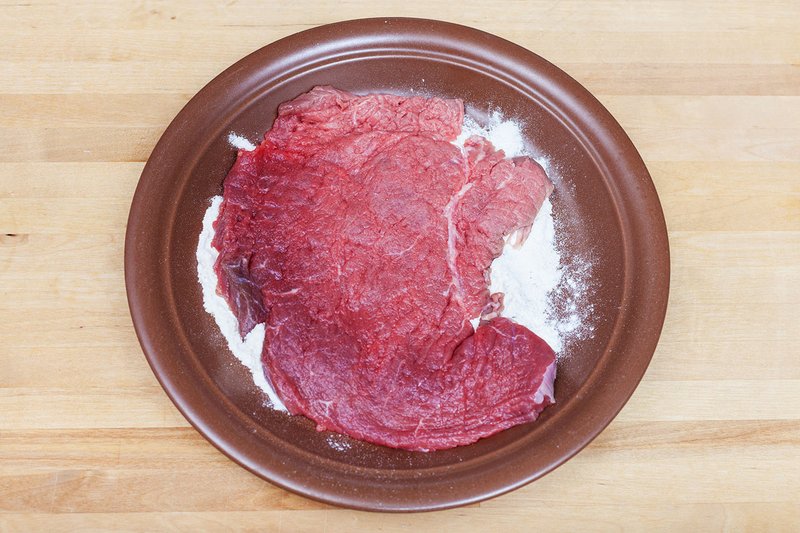Food lovers talk a lot about “secret menus” at their favorite restaurants (usually fast-food places) that clue people in on all sorts of special variations they order — only if they know about them. But even at fine restaurants, like my original Spago in Beverly Hills, there are secret items that anyone with the inside knowledge can ask for. One of the biggest secrets is the fact that, whether it happens to be on the day’s menu or not, you can get a Wiener schnitzel, the thin, crisply breaded and deep-fried veal cutlet that’s a specialty of Austria’s capital, Vienna (or Wien in my native language).
I find it interesting, though, when people refer to the dish simply as a schnitzel, because that word is too broad to refer to the Viennese favorite alone. When translated, schnitzel means “little slice.” And in meaning, it’s no different from the most common English equivalent: “cutlet.” Like cutlets, schnitzels can be made from a wide variety of meats beyond veal, including pork, chicken and turkey; in fact, growing up, my mother and grandmother usually made them for us with pork, far less expensive than veal.
The variety doesn’t end there, either. There are also so many different styles of schnitzel recipes across Austria and Germany. Depending on the restaurant and the region, you might find dishes such as zigeuner (gypsy-style) schnitzel sauteed with tomatoes, peppers and onions; Munchner (Munich-style) schnitzel lightly spread with horseradish or mustard underneath its breadcrumb coating; Jager (hunter-style) schnitzel, smaller slices sauteed and served with a woodland mushroom sauce; and so many more.
One of my favorite schnitzels, however, is a Holsteiner version. It was first created in a Berlin restaurant in the late 19th century for an important customer, German statesman Friedrich von Holstein. It appears he liked rich, piquant flavors, for his schnitzel was first lightly floured and then sauteed in both butter and oil; then the pan drippings were transformed into a sauce with chicken stock, concentrated veal stock (for which I substitute a little barbecue sauce), lemon juice and capers; and finally served topped with a fried egg and a garnish of anchovy fillets (which you can certainly omit if you aren’t a fan).
I know this may all seem unusual at first. But think about it, and you might suddenly realize that your mouth begins to water. Mine does. It’s a delicious combination of flavors. It’s also much easier to make than a Wiener schnitzel, requiring no deep frying. I haven’t yet added it to any secret menus in my restaurants. But you never know ….
HOLSTEINER SCHNITZEL WITH FRIED EGG
Serves 4
Ingredients:
4 boneless slices veal or pork cut from the leg or loin, each 6 to 7 ounces
1 cup all-purpose flour
Kosher salt
Freshly ground black pepper
About 3/4 cup vegetable oil
8 tablespoons (1 stick) unsalted butter
4 large eggs
2 cups good-quality low-sodium store-bought chicken stock or broth
2 1/2 tablespoons fresh lemon juice
2 1/2 tablespoons good-quality bottled barbecue sauce
2 tablespoons drained capers
1/4 cup chopped fresh Italian parsley
16 anchovy fillets, patted dry with paper towels, optional
Directions:
First, pound and flatten the meat: Place a veal or pork slice in a large, heavy-duty resealable plastic bag. Close the bag loosely. With the flat side of a meat mallet, gently pound the meat to a thin, even cutlet about 1/8-inch thick. Repeat with the remaining meat.
Spread the flour on a large plate. Working with one cutlet at a time, season on both sides with salt and pepper. Dredge both sides of each cutlet in flour, coating completely, then tapping off excess flour.
Position a rack in the center of the oven, and heat the oven to 300 degrees. Place a rack on a large rimmed baking sheet.
Heat a large skillet over high heat. Add 2 tablespoons oil and 1/2 tablespoon butter. With tongs, add a cutlet. Cook until the bottom is golden brown, 3 to 4 minutes. Turn, and cook the other side. Transfer to the baking sheet, and keep warm in the oven. Cook the remaining 3 cutlets the same way, using a little more oil and butter as needed.
When you’ve finished cooking the meat, fry the eggs. Heat the remaining oil and all but 4 tablespoons of the remaining butter in a large nonstick skillet over medium heat, swirling to blend. Sprinkle in some salt and pepper. When the butter foams, break each egg one at a time into a bowl and then slide it into the pan, spacing them apart. Cook until the whites are set but the yolks are still soft, 2 to 3 minutes, basting the tops of the eggs with the hot butter and oil as they cook.
Meanwhile, pour off and discard the fat from the skillet in which you cooked the cutlets. Return the skillet to the stove over medium-high heat, and add the chicken stock, lemon juice and barbecue sauce, whisking to deglaze the pan deposits. Whisk in the remaining 4 tablespoons of butter. Add the capers, and season to taste with pepper. Swirl in the parsley. Remove the skillet from the heat.
To serve, transfer the cutlets to individual serving plates. Top each with a fried egg, including some butter from the pan. Spoon the pan sauce and capers over and around each serving. Arrange the anchovies on top. Serve immediately.
